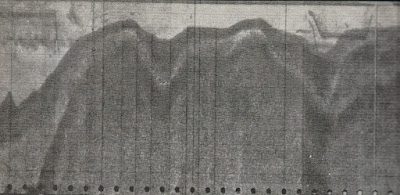The set of photographs taken by Mrs. Chie Kelly that appeared a few days ago continue to generate interest and debate. I penned my own initial reaction having found five of the fifteen images amongst various media articles but though they generated a degree of anticipation, I wasn't going to dive in deep without seeing the complete run of images. In the meantime, as I await such a development, I looked to see what other people were saying.
If they are images of the Loch Ness Monster, their detail and clarity may never have been surpassed - depending on what you think of others alleged monster photographs. So the clearer the picture, the more unanimous and convergent the opinions? Nothing could be further from the truth! These are some of the interpretations I found on some Facebook forums:
- giant eel
- seal(s)
- crocodile
- otter or seal being attacked by a reptile
- a big cat carrying prey
- leatherback turtles
- water snakes
- salamander
- two bin bags
- half-sunken dinghy
- tarpaulin
- pareidolia
- dog carrying something
- dead deer
- degraded two man kayak
- two people swimming with rucksacks
Clearly, a lot of these ideas are non-starters but the Daily Mail ran an article which gave us the opinion of Ben Garrod, a biology professor at the University of East Anglia:
However, biologist professor Ben Garrod told the programme that the thinks the humps are something far less exciting - such as debris from a boat or a lump of wood. He added that he doesn't believe that Nessie would be a prehistoric monster - as these were huge and sometimes violent, quick creatures, which would have made their presence known by now.
'As a biologist I would say if we're looking for an animal and we haven't seen it in approximately 50 years or we haven't got conclusive proof it's there, it's extinct.'
However, he thought it might well be 'a massive fish'.
So, a piece of floating wood and not a prehistoric monster as we would have some bodies dotting the shoreline by now - and I don't mean sunbathing. No aquatic dinosaurs but a vague reference to massive fish. Perhaps someone could clarify this as another later Mail article quotes a Hayley Stevens, identified as a paranormal researcher (though actually a sceptic of the paranormal):
But after their publication, paranormal researcher Hayley Stevens said: ‘I personally think it is most likely they saw a large sturgeon in the loch. The photos were taken in August and sturgeon migrate into fresh water in late summer and early autumn to mate.’
She added that native sturgeon are large – growing up to five metres in length.
I suppose the Daily Mail regarded these answers as expert opinion, but they come across as ill-informed and hasty. Now if the two had been presented with only the image shown at the top of this article, you might give them some leeway, but how can this two humped object possibly be called a sturgeon which has no such contours (compare below)? In fact, when the second image below is brought in, driftwood and sturgeon look like wholly inadequate explanations.
If one takes a look at Hayley's original piece, she attempts to answer why she thinks this is the best explanation.
The golden rule for solving ghost and monster mysteries is to keep it simple. Although it can be tempting to let your imagination run wild, the simplest solutions are almost always the correct answer, so start with those. Lay out what you already know and more often than not, the knowledge gaps fill themselves in.
Instead, when Nessie makes the news, people rush in with wild theories about what’s in a photo – theories that often have very little evidential basis to them. I’ve seen it suggested that this could be a deflating inflatable raft or an otter sitting on a ray. These suggestions may not be as farfetched as the idea that a dinosaur survives in the Loch, but they’re still pretty wild…
So, keep it simple, it's a sturgeon .. except the photos look nothing like a sturgeon and no sturgeon has ever been caught in Loch Ness. Apart from these minor points, it's a great theory. Perhaps sturgeon have made their way into the loch at some point in the past but their depleted numbers today suggest this is even more unlikely than past decades. I also doubt a sturgeon getting into Loch Ness to mate (with what?) is ever going to get back out.
So the clearer the picture, the more convergent the opinions? Not likely, it looks more like an exercise in hammering your favourite square peg into a round hole! Hayley even accuses Nessie believers of infighting over such images. I beg to differ, I see the discussions as largely civilized with the odd cross words being the minority. Of course, the vast majority of ideas are wrong, only one or none of them can be right.
What we have here is the marketplace of ideas on the Internet and like a real marketplace the worst ideas don't sell much, are ignored and fade away. Of course, some bad ideas still get bought like cheap pairs of shoes, nothing is perfect where people are involved. But driftwood will eventually sink and sturgeon will eventually stink. Will this winnowing of ideas eventually leave us with the true explanation? The answer to that is no, but I would hope that if and when we see more data, an awful lot of dross would have been cleared out by then.
Comments can be made at the Loch Ness Mystery Blog Facebook group.
The author can also be contacted at lochnesskelpie@gmail.com




































